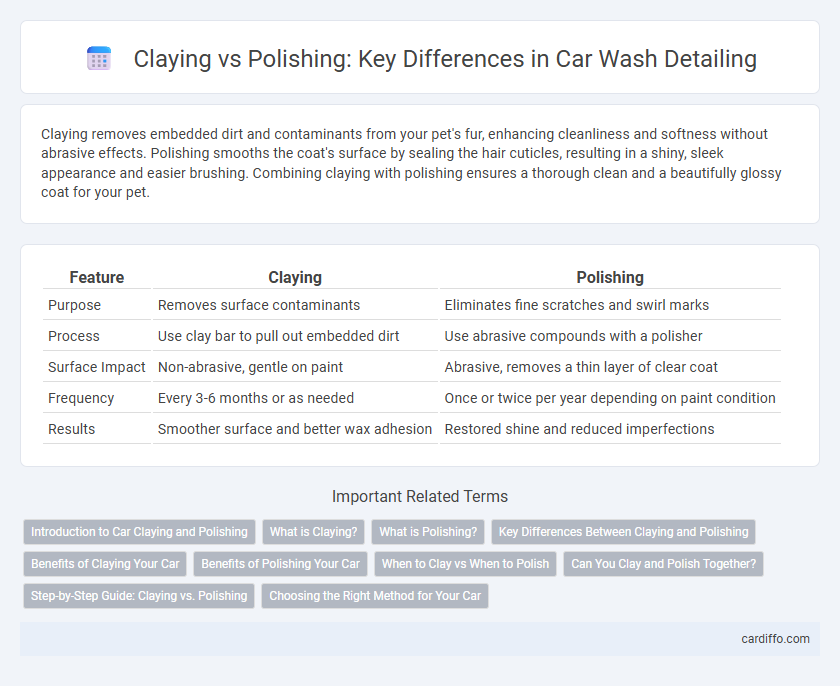Claying removes embedded dirt and contaminants from your pet's fur, enhancing cleanliness and softness without abrasive effects. Polishing smooths the coat's surface by sealing the hair cuticles, resulting in a shiny, sleek appearance and easier brushing. Combining claying with polishing ensures a thorough clean and a beautifully glossy coat for your pet.
Table of Comparison
| Feature | Claying | Polishing |
|---|---|---|
| Purpose | Removes surface contaminants | Eliminates fine scratches and swirl marks |
| Process | Use clay bar to pull out embedded dirt | Use abrasive compounds with a polisher |
| Surface Impact | Non-abrasive, gentle on paint | Abrasive, removes a thin layer of clear coat |
| Frequency | Every 3-6 months or as needed | Once or twice per year depending on paint condition |
| Results | Smoother surface and better wax adhesion | Restored shine and reduced imperfections |
Introduction to Car Claying and Polishing
Car claying removes embedded contaminants like tar, tree sap, and brake dust from the paint surface, restoring smoothness and improving paint adhesion. Polishing refines the paint by eliminating minor scratches, swirl marks, and oxidation to enhance gloss and depth. Combining claying with polishing creates a flawless finish and prepares the vehicle for waxing or sealing.
What is Claying?
Claying is a car detailing process that uses a specialized clay bar to remove embedded contaminants such as tar, tree sap, and industrial fallout from a vehicle's paint surface. This technique restores smoothness and prepares the paint for polishing or waxing by eliminating particles that washing alone cannot remove. Regular claying enhances paint clarity and ensures better adhesion of protective coatings.
What is Polishing?
Polishing is a car care process that removes minor surface imperfections such as scratches, oxidation, and swirl marks by using abrasive compounds and a polishing machine or hand applicator. It restores the paint's smoothness and enhances its gloss, creating a reflective finish that improves the vehicle's overall appearance. Unlike claying, which only removes surface contaminants, polishing actively refines the paint surface for a deeper shine.
Key Differences Between Claying and Polishing
Claying removes surface contaminants like tar, sap, and industrial fallout that regular washing cannot eliminate, restoring a smooth paint finish. Polishing, on the other hand, corrects paint imperfections such as swirl marks, light scratches, and oxidation by removing a thin layer of clear coat. While claying focuses on decontamination, polishing aims to enhance paint clarity and gloss for a refined appearance.
Benefits of Claying Your Car
Claying your car removes embedded contaminants like industrial fallout, tree sap, and brake dust that regular washing cannot eliminate, restoring a smooth and clean surface. This process enhances paint clarity and allows for better adhesion of wax or sealant, increasing the durability of protective coatings. Claying also helps prevent paint damage and oxidation, extending the life and appearance of your vehicle's finish.
Benefits of Polishing Your Car
Polishing your car enhances paint clarity and restores the vehicle's original shine by removing fine scratches, swirl marks, and oxidation. This process refines the surface at a microscopic level, providing a smooth, reflective finish that boosts the car's aesthetic appeal and resale value. Regular polishing also helps prepare the paint for protective wax or sealant applications, prolonging the lifespan of the exterior finish.
When to Clay vs When to Polish
Claying is essential when removing surface contaminants like tree sap, industrial fallout, or bonded dirt that cannot be cleaned through regular washing, providing a smooth base for further detailing. Polishing is best suited for removing minor paint imperfections such as swirl marks, oxidation, or light scratches after claying has cleaned the surface. Use claying first to ensure a contaminant-free surface, then polish to restore clarity and enhance the paint's gloss.
Can You Clay and Polish Together?
Claying and polishing can be performed together to achieve a smooth, glossy finish on a vehicle's paintwork. Claying removes embedded contaminants that washing alone cannot, while polishing corrects minor scratches and oxidation, restoring clarity and shine. For best results, clay first to prepare the surface, then polish to enhance and protect the paint.
Step-by-Step Guide: Claying vs. Polishing
Claying removes surface contaminants such as tar, sap, and industrial fallout by gently lifting them from the paint, while polishing refines the paint's finish by eliminating swirl marks, oxidation, and fine scratches. Begin claying with a clay bar and lubricant, working in small sections with light pressure, then rinse and dry before moving to polishing. Polish using a dual-action polisher or by hand with a quality polish, applying consistent pressure and overlapping passes to restore gloss and smoothness.
Choosing the Right Method for Your Car
Claying removes surface contaminants like tar, sap, and brake dust, making it ideal before polishing to ensure a smooth, clean finish. Polishing restores paintwork by eliminating swirl marks, light scratches, and oxidation, enhancing gloss and depth. For a flawless car wash, start with claying to prep the surface, followed by polishing to achieve a showroom shine.
Claying vs Polishing Infographic

 cardiffo.com
cardiffo.com